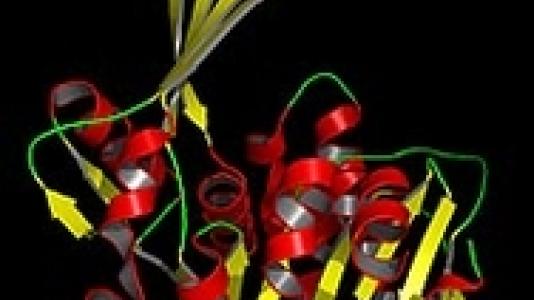
ARGONNE, Ill. — Researchers from the Midwest Center for Structural Genomics, located at the U.S. Department of Energy’s Argonne National Laboratory, have deposited their 500th structure to the Protein Data Bank – identifying the structure of an enzyme in the key bacterium for modifying and improving crop production.
The Protein Data Bank is the single worldwide depository of information about the three-dimensional structures of large biological molecules, found in all organisms, including bacteria, yeast, plants, flies and mice, as well as humans. Understanding the shape of a molecule helps scientists understand how it works. The Protein Data Bank is a portal for information about these molecules, and as such enables research and education about the molecular basis of life.
The 500th structure deposited in the data bank by MCSG researchers is a phosphofructokinase from the bacteria Agrobacterium tumefaciens, a plant pathogen. This phosphofructokinase belongs to a ribokinase family of enzymes important in regulating the process of fermentation, by which one molecule of the simple sugar glucose is broken down to two molecules of pyruvic acid.
A. tumefaciens is harmful to plants and useful to scientists for the same reason: It transfers DNA into plant genomes. Found in soil worldwide, A. tumefaciens causes disease in plants by transferring its own DNA into plant cells. But in the laboratory, the ability to move all sorts of genes into plants has made the microbe the standard tool for investigating plant genetics and modifying crops.
The Midwest Center for Structural Genomics is one of four large-scale research centers of the Protein Structure Initiative, funded by the National Institutes of Health (NIH). The MCSG, a consortium made up of scientists from Argonne National Laboratory, European Bioinformatics Institute, Northwestern University, University of Toronto, Washington University, University College London, University of Virginia and the University of Texas, has as its goal the discovery of three-dimensional structures of proteins obtainable from knowledge of their corresponding DNA sequences.
In the last 40 years, structural biology has been successful at addressing fundamental mechanical and functional questions in biology. The complete understanding of biological systems requires detailed knowledge of protein functions and their interactions with other proteins and cellular components. Because protein function is associated with 3-D protein structures, knowledge of the protein structure is essential.
An important turning point for North American efforts in structural genomics was Argonne’s 1998 Structural Genomics meeting co-organized by MCSG Director Andrzej Joachimiak. This meeting brought together researchers and members of funding agencies who recognized that improvements in technology coupled with the successes of genome sequencing projects had paved the way for a large-scale structure determination project.
“X-ray crystallography of macromolecules, in particular, has seen remarkable progress in recent years,” said Joachimiak, who is also director of Argonne’s Structural Biology Center (SBC), a national user facility for macromolecular crystallography. “These advances were made possible by the public investment in the development of third-generation synchrotron sources.”
The second, production phase of the NIH’s Protein Structure Initiative, which is currently underway, has a primary goal of large-scale structure determination to maximize the coverage of protein sequence space by structural information. A majority of the 500 structures solved by the MCSG have been derived from human pathogens and have unique sequences. Among the characterized proteins is the structure of Hcp1 protein from Pseudomonas aeruginosa – an important component of a new secretion apparatus. Determining these structures helps scientists better understand function and biology of these organisms and in some cases helps create uniquely designed, targeted drugs and vaccines.
New technology developed for structural genomics has greatly increased the efficiency of protein structure determination. These advances have contributed to the creation of one of the most efficient “high-throughput” pipelines, which the MCSG applies to many novel protein families with no structural representative and to biomedically important protein targets. The Argonne staff at the MCSG is continuously improving and modernizing its capabilities to improve efficiency and to determine structures of the most challenging protein targets.
“Forty years ago it took researchers worldwide 16 years to deposit the first 25 structures into the PDB,” said Joachimiak. “By November 2003, the MCSG had deposited its first 100 structures, and in the past three years we have deposited an additional 400 structures. We have put together an outstanding team and technology that contribute in many different ways to this project. All structures are determined using the SBC beamlines that provide outstanding facilities for data collection at the Advanced Photon Source.” — Andrea Cipriani